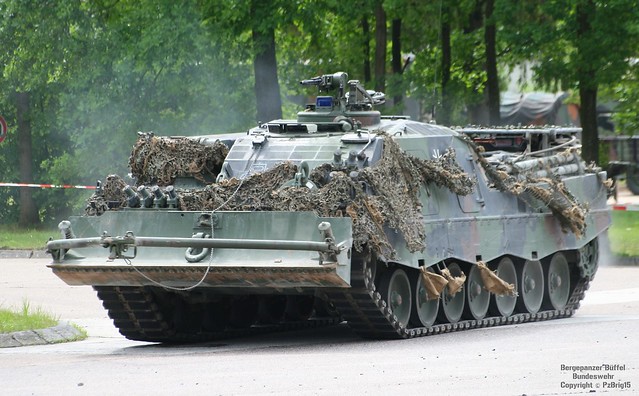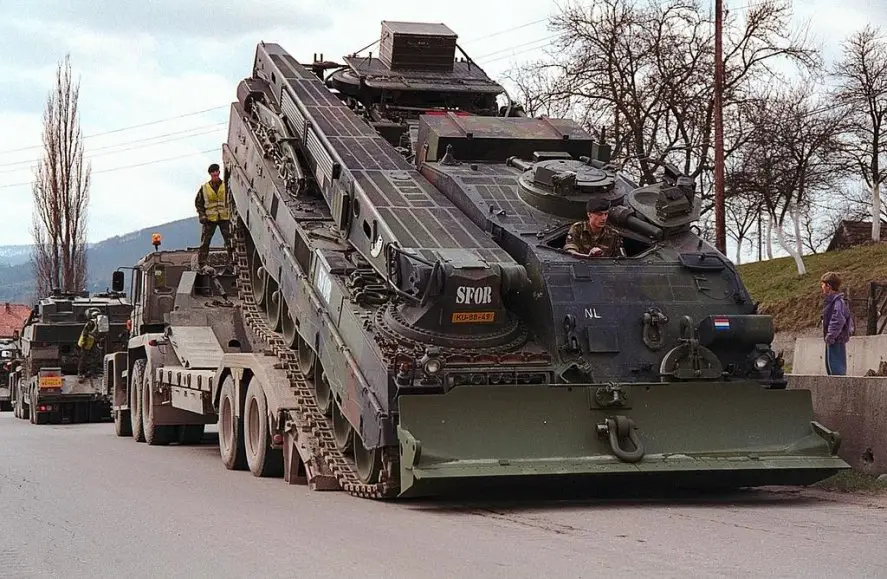Saturday
Buffel - Armored Recovery Vehicle
The Bergepanzer 3 Buffel (Buffalo) armored recovery vehicle was developed by Rheinmetall. It is based on the Leopard 2 chassis and is fitted with powerful recovery system. With introduction of the Leopard 2 main battle tank in 1979 it appeared that the previous Bergepanzer 2A2, based on the Leopard 1 MBT chassis, was not powerful enough to support the new main battle tank. A development program for a new armored recovery vehicle was launched. The first prototypes of the Bergepanzer 3 were completed in 1988. Deliveries of the new ARV commenced in the early 90s.
The Buffel ARV is currently in service with Germany, Canada, Greece, the Netherlands, Singapore, Spain, Sweden and Switzerland. Components of the Buffel, like the crane, dozer blade are installed on the South Korean K1 ARV, French Leclerc DNG armored recovery vehicles.
The Bergepanzer 3 is fitted with a crane, winch and front-mounted dozer. The main mission of the Buffel is recovery of damaged, overturned and swamped main battle tanks and other tracked vehicles. It also provides maintenance service or tows them to maintenance units. Other tasks of the Buffel include general dozing and obstacle removal.
The Buffel has a large crane installed on the rotary platform, which is capable of lifting 30 000 kg. The crane can be traversed 270 degrees. It has an electronic momentum limiter, which prevents overloading. It is capable of lifting the turret of most main battle tanks. It is also used to lift powerpacks of the MBTs, or for other load-lifting works. If repairs are required to a vehicle's suspension, the crane raises the front of back of the vehicle to allow access to the damaged system. When not required the crane lays along the right side of the hull.
The Bergepanzer 3 carries a spare powerpack at the rear of the hull. It can replace the powerpack of the Leopard 2 within 25-35 minutes, depending on the version of the tank.
The main mechanical winch is installed at the front of the hull. It is provided with 180 m of cable and has a traction force of 35 t. With the help of pulley blocks traction force is increased to 70 t. The main winch of the Bergepanzer 3 is used for recovery of damaged, stuck, sunken and overturned vehicles.
The Buffel armored recovery vehicle tows damaged, faulty or uncontrolled vehicles, or similar type tanks using rigid or non-rigid hitches. Crew can connect a rigid hitch under armor from inside of the hull without exiting the vehicle. The Buffel has a towing capacity of 62 000 kg. Vehicles are towed to the nearest shelters, assembly points of repair depots.
This combat vehicle has a welding outfit for welding and cutting works in the field. These are carried by one of the crew member. The Buffel also has a set of tools for field repairs.
The front-mounted dozer blade is used for clearing obstacles and earth-mowing works, such as preparation of firing positions, covering up of ditches, self-entrenching and so on. The dozer blade is also used to stabilize the vehicle during craning and winching operations.
The Buffel carries a single 7.62-mm machine gun for self-defense. There are also 16 smoke grenade dischargers. Vehicle has an automatic fire suppression system and NBC protection system for the crew.
This armored recovery vehicle has a crew of three, including commander, driver and handler. During peacetime the Buffel is operated by a crew of two. Access to the inside of the vehicle is provided by three large doors.
The Buffel is powered by MTU MB 837 Ka-501 turbocharged diesel engine, developing 1 500 hp. It uses the same engine as the Leopard 2 main battle tank. With preparation this armored recovery vehicle fords water obstacles up to 4 m deep.
Source
Labels:
German,
Support Vehicle
Subscribe to:
Post Comments (Atom)

-111.jpg)


No comments:
Post a Comment